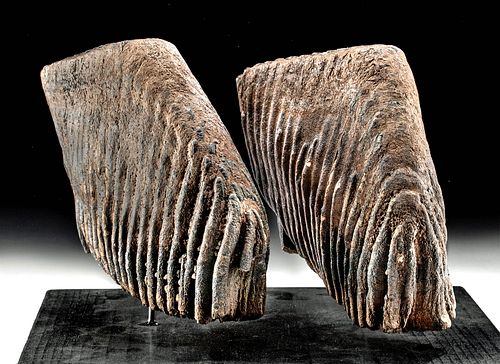Huge Matched Pair of Woolly Mammoth Molars - Rare!
Lot 103
About Seller
Artemis Gallery
686 S Taylor Ave, Ste 106
Louisville, CO 80027
United States
Selling antiquities, ancient and ethnographic art online since 1993, Artemis Gallery specializes in Classical Antiquities (Egyptian, Greek, Roman, Near Eastern), Asian, Pre-Columbian, African / Tribal / Oceanographic art. Our extensive inventory includes pottery, stone, metal, wood, glass and textil...Read more
Categories
Estimate:
$2,400 - $3,600
Absentee vs Live bid
Two ways to bid:
- Leave a max absentee bid and the platform will bid on your behalf up to your maximum bid during the live auction.
- Bid live during the auction and your bids will be submitted real-time to the auctioneer.
Bid Increments
| Price | Bid Increment |
|---|---|
| $0 | $25 |
| $300 | $50 |
| $1,000 | $100 |
| $2,000 | $250 |
| $5,000 | $500 |
| $10,000 | $1,000 |
| $20,000 | $2,500 |
| $50,000 | $5,000 |
| $100,000 | $10,000 |
| $200,000 | $20,000 |
About Auction
By Artemis Gallery
Oct 8, 2020
Set Reminder
2020-10-08 10:00:00
2020-10-08 10:00:00
America/New_York
Bidsquare
Bidsquare : Exceptional Antiquities, Asian, Ethnographic
https://www.bidsquare.com/auctions/artemis-gallery/exceptional-antiquities-asian-ethnographic-5796
Museum-worthy examples of Egyptian, Greek, Roman, Etruscan, Near Eastern, Far East / Asian, Pre-Columbian, African / Tribal,Oceanic, Native American, Spanish Colonial, Russian, Fossils, Ancient Jewelry, Fine Art, so much more! Artemis Gallery info@artemisgallery.com
Museum-worthy examples of Egyptian, Greek, Roman, Etruscan, Near Eastern, Far East / Asian, Pre-Columbian, African / Tribal,Oceanic, Native American, Spanish Colonial, Russian, Fossils, Ancient Jewelry, Fine Art, so much more! Artemis Gallery info@artemisgallery.com
- Lot Description
Alaska, Pliocene to Pleistocene (Ice Age), ca. 100,000 to 20,000 years old. A matched pair of fossilized lower left and right molars from a mammoth. Remarkably well preserved, these nearly identical massive gnashers present with a flat occlusal surface each holding twenty-six vertical black wavy lines of the enamel ridges and diagonal distal sides curving down to the long shag-like roots and one thick root separated from the others towards the slightly slanted mesial face. The number of enamel ridges identifies this mammoth as the woolly mammoth of Alaska, while the curved shape of the molars and split root tells us that these are lower teeth. As a mammoth grows six sets of molars in its 60-year lifespan, its approximate age when the molars fall out can be determined by the size of the lost tooth. This molar measures nearly 7.5" long, indicating the mammoth was most likely 30 to 50 years old when the tooth was lost. The glistening mottled quartz on the edge of the mesial and occlusal sides further enhances the beauty of this ancient beast! Size: 11.25" L x 11.25" W (28.6 cm x 28.6 cm); 8" H (20.3 cm) on included custom stand.
The original chemicals of the teeth have been replaced in the fossilization process with quartz (silica) and other minerals, which may give a clue to its place of origin. For example, fossils found in the Wind River Formation in Wyoming have often been replaced by silica. Mammoth teeth are highly specialized, some of the largest grinding teeth in the animal kingdom, adapted to crush woody vegetable matter in ancient forests.
Provenance: ex private Hagar collection, Wildwood, Missouri, USA
All items legal to buy/sell under U.S. Statute covering cultural patrimony Code 2600, CHAPTER 14, and are guaranteed to be as described or your money back.
A Certificate of Authenticity will accompany all winning bids.
We ship worldwide and handle all shipping in-house for your convenience.
#159353One molar has a broken bottom section of about 1.5" on its two back roots. Light abrasions to the outside facing surfaces of both. Surface wear commensurate with age. Earthen deposits and small white and tan pebbles wedged throughout highlight the well defined roots with nice contrasts of color! Overall in excellent condition.Condition
- Shipping Info
-
All shipping is handled in-house for your convenience. Your invoice from Artemis Gallery will include shipping calculation instructions. If in doubt, please inquire BEFORE bidding for estimated shipping costs for individual items.
-
- Buyer's Premium



 EUR
EUR CAD
CAD AUD
AUD GBP
GBP MXN
MXN HKD
HKD CNY
CNY MYR
MYR SEK
SEK SGD
SGD CHF
CHF THB
THB













